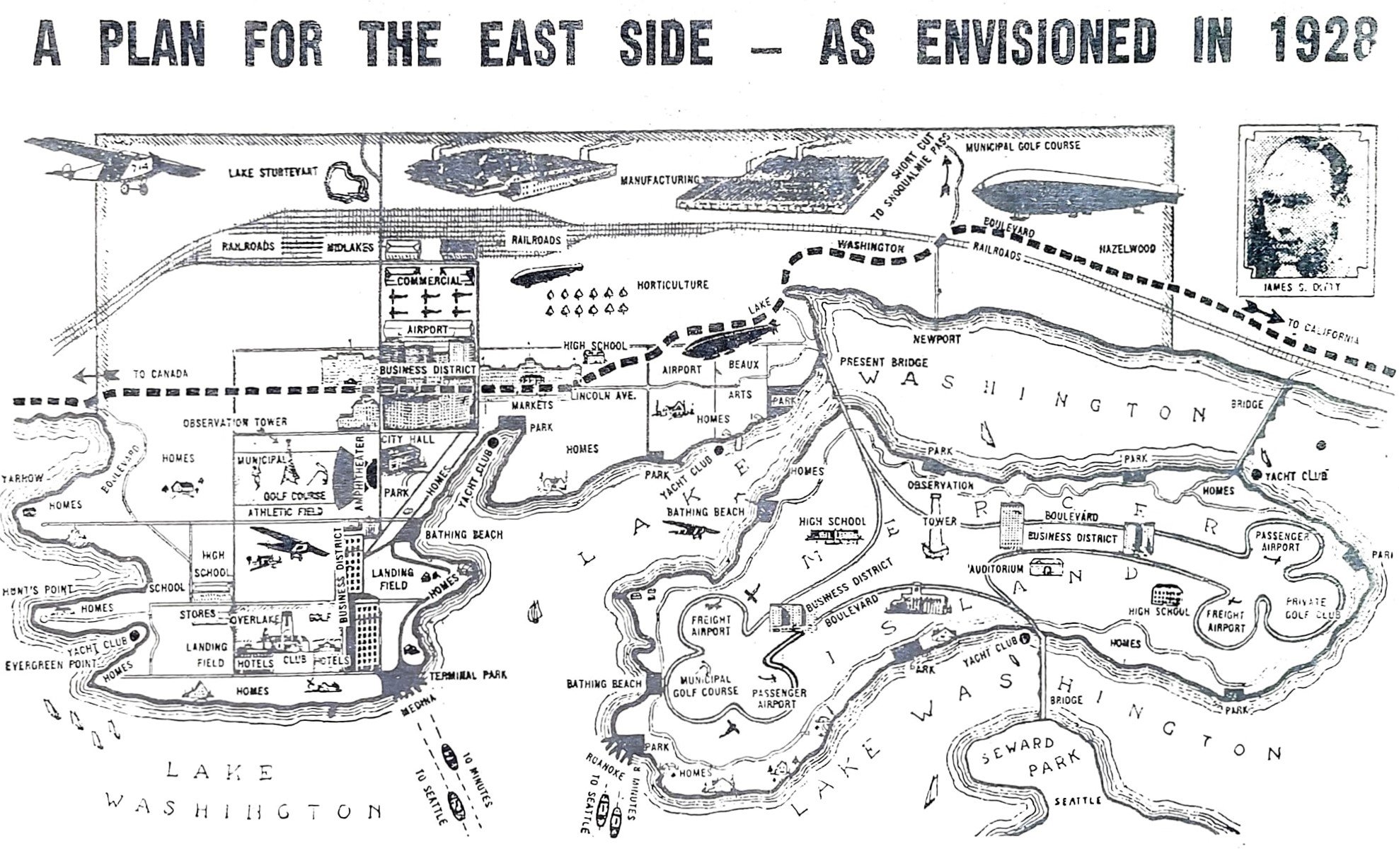By Steve Williams, EASTSIDE HERITAGE CENTER VOLUNTEER
Before “Seafair” the Eastside event of the summer was the “Sammamish Slough Race”. Starting in the spring of 1928 and running for another 48 years, motorboats raced each other up and down the 13 mile narrow 'river' connecting Lake Washington and Lake Sammamish. As the map shows, it was a torturous route with hazards including 63 sharp turns, bridge pilings, sandbars and occasional floating logs. Steve Greaves, who started racing at age 14 and went on to set over 30 world and national records, said “There was really nothing like it in the country. Even today most will tell you it was one of their favorites. It was certainly the craziest. I remember coming around a bend going through Redmond and having to dodge a cow getting a drink of water.”
KFKF Radio flyer, with Sammamish Slough power boat race route, April 1969 (2004.015)
An estimated 40,000 spectators watched from bridges and river banks on the tight corners where wild crashes and side flips often occurred. Sometimes spectators would help racers get their boat back in the water, or if it couldn't be repaired, hand the driver a beer and invite him to watch the race with them. In later years there were five different classes of boats and over 100 entries, some from Tacoma, Hoquiam, and even Oregon. (The number of spectators probably doubled). With the development of small hydroplanes speeds hit 80mph, but nearly a third of the racers often failed to finish due to crashes or mechanical problems. Spectators noted the special 'race smell' of the alcohol fuel burned by the hydros, and said that “hearing the boats coming long before seeing them turn the corner added to the excitement.”
1962 Bob Carver / Seattle Times (EHC Vertical Files)
According to Seattle Times reporter Craig Smith, “A different division would start every five minutes from Lake Washington and head upstream. Waiting with cameras poised at the most dangerous turns were newspaper photographers and cameramen from Movietone, who would film crashes that would be shown in the nation's theaters.” Howard Anderson, a national VP of the American Power Boat Association said, “I don't think there was a race like it in the nation, ever.” Dick Rautenberg, a competitor from Bothell agreed, saying, “That was the most fun of any racing we've done.”
1963 Seattle Times (EHC Vertical Files)
Another significant local event happened in 1953 when the Golden Water Ski Club teamed up with the Seattle Outboard Association to race towed skiers up and down the Slough. The upstream inning time was 24:37 minutes, while downstream with the current, slow as it was, cut the time to 22:43. Of course all the turns made it fun for the skiers and even more challenging for the drivers.
The Slough itself had a long and storied boating history. Native canoes traveled up and down, but were also used in gathering plant material, and in fishing and hunting waterfowl. Small scows and narrow steamboats arrived with settlers in the 1880's. (A few even had hinged smokestacks that could be folded down when going under low bridges). For half a century, logs were floated or towed downriver to sawmills - during spring floods havoc occurred as log-jams blocked the river and farmers fields were covered with water for months at a time.
In 1964 – 1966 it all changed when the U.S. Army Corps of Engineers dredged and widened the Slough. The 3.8 million dollar flood control project took out 30 miles of 'squiggles and kinks' and straightened it to 10 miles of 'steep-sided ditch.' A concrete weir, or submerged dam, at Marymoor Park now keeps Lake Sammamish at a relatively constant level, and there is a nice paved bicycle trail running along the high bank of the slow moving 'Slough'. The thrill is gone, but the excitement and challenge of the “Race” will long be remembered as the Eastside's precursor to “Seafair.”
Sources:
10/21/1999 Seattle Times article “Old river new routes” by Peyton Whitely.
4/15/1994 Seattle Times article “Unpredictable 'Slough Race' a bygone rite of spring” by Craig Smith.
3/24/1963 Seattle Times article “The Taming of the Slough” by Eileen Crimmin.
5/2013 newsletter of the Redmond Historical Society “Showcasing Our History: Sammamish River Races”.
4/2014 newsletter of the Redmond Historical Society “Northwest Original: The Sammamish Slough Race”.
7/1953 magazine; “Sea and Pacific Motor Boat” report of Russell Swanson.
2015 book; “Lake Sammamish Through Time” by Kate N. Thibodeau.
3/30/1977 Sammamish Valley News, article by Wendy Reif "Slough Race bottoms out"















